
High
Performance Electronic Fuel Injection for air cooled VW Engines is
now a reality. You can easily install and run it on most VW Engines.
But don't confuse the new generation of fuel injection with the original
injection offered as factory equipment by Volkswagen. The new stuff
is high performance, solid state multi point and it represents a new
era in fuel injection for air cooled VW Engines. CB's new system is
easy to install, dash adjustable, and makes gobs of horsepower.
This new system
is based on the normally aspirated Competition & Ultra Competition
Fuel Injection Systems. Unlike other turbo systems, it runs with only
three engine sensors. The oxygen sensor found on other fuel injection
systems is not used. Its absence allows you to run leaded high octane
racing fuel, or any other blend of leaded or unleaded fuel. The absence
of the oxygen sensor and other circuits also means that the engine
is not overly vacuum sensitive. This roughly translates into the fact
that you can run you Turbo Competition System with just about any
camshaft!
The key feature
of this new turbo system is the four knob dash module. What ever tuning
needs to be done, can be done from right inside the car. The dash
module is actually a tiny microprocessor that enables you to create
fuel curves right from the drivers seat. Beginning from left to right,
you start with the idle knob. The idle knob adjusts the idle fuel
mixture. Next is the low control knob. This knob sets the low to midrange
mixture. To the right of the low control knob, is the knob labeled
"switch." The switch knob takes care of separating the idle
and low speed features from the high end range. This is done by adjusting
voltage. The last knob on the right sets the all out top end horsepower.
With these four knobs, any imaginable fuel curve is possible.
At first glance,
an engine set up with CB's electronic fuel injection looks similar
to an engine with dual carburetors. A second look will show you that
there are no mixture screws, accelerator pump arms, or float bowls.
That's because CB designed their throttle bodies to match the hardware
normally used with Weber IDF or Dellorto DRLA carburetors. The throttle
bodies are designed to position one electronic fuel injector in each
intake port. The result is state of the art port on port timed fuel
injection.
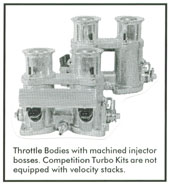 40mm
and 48mm throttle bodies are available. Throttle bodies flow an abundance
of air. A set of 48mm throttle bodies will outflow a set of 52mm carburetors.
The reason becomes very obvious when you look down the barrels of
a throttle body. The bores of a throttle body are clean, without any
restrictions to air flow. Secondary venturii, accelerator pump jets,
and restrictive primary venturii are not needed when you run electronic
fuel injection. With CB's fuel injection, air flow has a clean, nonrestrictive
shot right through the bodies and into the combustion chambers. That's
only one of the reasons that fuel injection makes more power than
carburetors. We'll talk about some more reasons why CFI out produces
carburetors later on.
40mm
and 48mm throttle bodies are available. Throttle bodies flow an abundance
of air. A set of 48mm throttle bodies will outflow a set of 52mm carburetors.
The reason becomes very obvious when you look down the barrels of
a throttle body. The bores of a throttle body are clean, without any
restrictions to air flow. Secondary venturii, accelerator pump jets,
and restrictive primary venturii are not needed when you run electronic
fuel injection. With CB's fuel injection, air flow has a clean, nonrestrictive
shot right through the bodies and into the combustion chambers. That's
only one of the reasons that fuel injection makes more power than
carburetors. We'll talk about some more reasons why CFI out produces
carburetors later on.
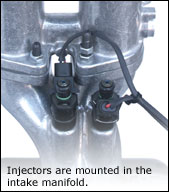 Installation
of a Competition Turbo Kit follows the same basic outline as with
any fuel injected turbo system. The fuel system must be installed
to insure circulation of fuel from the tank to the injectors and back
to the tank. The fuel pressure reached higher levels than that of
a normally aspirated injection system, so special care must be taken
during installation procedures.
Installation
of a Competition Turbo Kit follows the same basic outline as with
any fuel injected turbo system. The fuel system must be installed
to insure circulation of fuel from the tank to the injectors and back
to the tank. The fuel pressure reached higher levels than that of
a normally aspirated injection system, so special care must be taken
during installation procedures.
CB offers two
styles of throttle bodies. One type of throttle body has injector
bases machined for use with injectors. Throttle bodies of this type
will not fit into the standard VW sedan engine compartment unless
a space saver style manifold/linkage kit is used or major surgery
is performed to the sides of the body. This type of throttle body
is most often used on race cars or tube framed sand buggies. These
throttle bodies can be used with all IDF & DRLA manifolds and
throttle linkage. They can reduce the cost of converting over to fuel
injection. Just remove your carburetors and bolt on the throttle bodies.
The other style
of throttle body produced by CB Performance requires the use of special
intake manifolds. The manifolds locate the injectors inboard, between
the fan shroud in the manifolds. The use of this type of setup is
normally required when the fuel injection system is to be installed
in a VW sedan. The use of either type of throttle body will normally
provide a quantum leap in performance over carburetion for several
reasons. As we mentioned before, the increase in air flow when throttle
bodies are used is a positive factor.
The first step
to get your Turbo Fuel Injected vehicle up and running is to start
with the fuel system. You'll have to scrap your old fuel system and
pump because you're going to require a modern fuel delivery system.
One similar to that used on all new automobiles where fuel is pumped
from the tank, to injectors and pressure regulator under high pressure.
Fuel then returns to the tank at reduced pressure. A continuous supply
of fuel is circulated throughout the system. The fuel pressure is
regulated according to the engine's requirements.
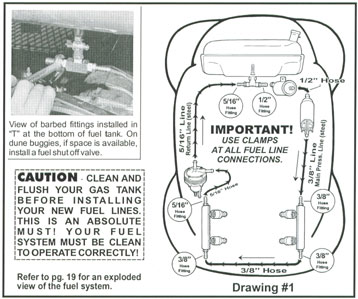 Replace
the present fuel line outlet at the bottom of your tank with the "T"
supplied in your kit. There are two supplied brass barbed fittings.
One 1/4" NPT x 1/2" hose (to the fuel filter - main fuel
supply) and one 1/4" NPT x 5/16" hose (used for the return
line of the fuel system). Be sure to use Teflon tape on fuel fittings.
Make certain not to get any excess Teflon or strings of Teflon into
the fuel system.
Replace
the present fuel line outlet at the bottom of your tank with the "T"
supplied in your kit. There are two supplied brass barbed fittings.
One 1/4" NPT x 1/2" hose (to the fuel filter - main fuel
supply) and one 1/4" NPT x 5/16" hose (used for the return
line of the fuel system). Be sure to use Teflon tape on fuel fittings.
Make certain not to get any excess Teflon or strings of Teflon into
the fuel system.
Mount the fuel
filter and fuel pump under the fuel tank and below the fuel level.
Use the supplied 1/2" hose to connect the fuel filter to the
fuel "T" and the other side of the filter to the pump. Be
sure to have the fuel from the tank enter the fuel filter before it
passes through the fuel pump. Installation is easy in a race car or
dune buggy, because most of these have rear mounted fuel tanks. Make
certain to use clamps on all connections.
Installation
in a VW sedan is a little more complicated because it requires the
installation of two steel fuel lines. One 3/8" line, used for
the main pressure line from the pump to one of the throttle bodies
and one 5/16" line for the return from the regulator to the tank.
On sedan installations the lines can be run so that one goes down
the passenger side of the car (main line) and the other line goes
down the drivers side of the car (return line), or vice versa depending
on how you choose to route the main and return lines. Doing it this
way creates a big circle. Fuel comes from the tank, to both throttle
bodies, to the regulator and back to the tank again. How ever you
decide on mounting the fuel lines for your system, make sure to use
the 1/2" fitting as the main fuel supply to the engine, and the
5/16" fitting as the return to the tank. These lines will be
running the length of the car,
rubber fuel line is not
an option here!
Rubber line can be used to connect all
hard line connections. Where ever a connection is to be made using
rubber line, do not use normal fuel line,
use only high
pressure fuel line!
When securing the hard lines to
the bottom of your car, use some type of rubberized clamp to help
reduce vibration.
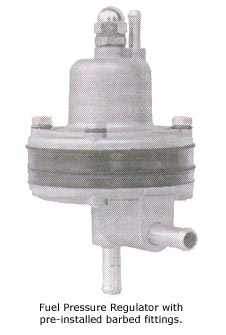 Two
styles of Fuel Pressure Regulators are available. One is tapped for
1/8" NPT and the other has pre installed 5/16" fittings.
The regulator can be secured to one end of the fuel rail, firewall,
engine, frame or whatever convenient. Do not mount the regulator on
or near the exhaust or any type of heat source. There are too many
variables for us to point out one specific location for the installer
to mount the fuel pressure regulator.
Two
styles of Fuel Pressure Regulators are available. One is tapped for
1/8" NPT and the other has pre installed 5/16" fittings.
The regulator can be secured to one end of the fuel rail, firewall,
engine, frame or whatever convenient. Do not mount the regulator on
or near the exhaust or any type of heat source. There are too many
variables for us to point out one specific location for the installer
to mount the fuel pressure regulator.
Installing fuel
injection is just about like bolting on a set of dual carburetors.
The only real departure in the procedure is in installing the injectors
into the fuel rails and then positioning the injectors into the ports.
As previously mentioned, two styles of throttle bodies are available.
The throttle bodies with injector bosses can be used with any IDF
or DRLA manifolds. The throttle bodies without machined injector bosses
require special intake manifolds with matching ports for injectors
in the manifolds. Each type of throttle body has its preferred uses.
The throttle bodies with injector ports broaden the application range
and can be used on type 1 and type 2 VW, 356, and 914 Porsche engines.
Either type
of throttle body can be used with a turbocharger. The important thing
is to make certain that the fuel rails are securely fixed in place
with retaining brackets to prevent turbo pressure from blowing the
injectors out of the bosses. In the next few pages we will explain
the assembly of both types of throttle bodies. The general use and
assembly is the same except for some hardware differences and the
mounting and retaining of the fuel rails.
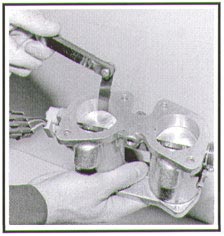 Before
the pre-assembly procedure of the throttle bodies and manifolds begins,
it's always a good idea to pre-tune your throttle bodies. Balancing
and dialing in a set of dual throttle bodies can be greatly simplified
by making certain that each throttle body is adjusted to the same
idle speed setting before you bolt 'em on. Let's call it pre-tuning.
You can pre-tune your throttle bodies by sliding a .003" feeler
gauge between the butterfly and the wall of the throttle bore. Make
certain that both throttle bodies are set at the same .003" opening.
Check only the butterflies nearest the idle speed adjusting screws.
Before
the pre-assembly procedure of the throttle bodies and manifolds begins,
it's always a good idea to pre-tune your throttle bodies. Balancing
and dialing in a set of dual throttle bodies can be greatly simplified
by making certain that each throttle body is adjusted to the same
idle speed setting before you bolt 'em on. Let's call it pre-tuning.
You can pre-tune your throttle bodies by sliding a .003" feeler
gauge between the butterfly and the wall of the throttle bore. Make
certain that both throttle bodies are set at the same .003" opening.
Check only the butterflies nearest the idle speed adjusting screws.
The idle speed
throttle settings obtained in this manager might not be exactly what
your engine requires to idle at a desired speed, but they will be
reasonably in sync. Increasing or decreasing the idle speed is just
a matter of turning the idle speed control screws in or out a 1/2
turn at a time, until a desired speed is reached. In for more idle
speed and out for less idle speed. Be sure to adjust the idle speed
screws equal and this will keep both throttle bodies closely in sync.
The function of throttle bodies is to control air flow. The trick
is to start out even and keep them even throughout the opening and
closing cycle. The feeler gauge is a good starting point, but the
finishing touch to a good balance job is the use of a Uni-Syn gauge,
we'll get into that maneuver later on.
Start by bolting
the throttle bodies to the intake manifolds. Each throttle body is
held in position by four 8mm studs. Throttle Bodies with fuel injectors
use all the same length studs. Kits with manifold mounted fuel injectors
require one 8 x 60mm stud to be threaded into the inboard hole that
lines up with both injector ports. One stud per manifold. These two
studs will be used for fuel rail retaining brackets. We will get into
fuel rail assembly and securing later on. Thread the short end of
the studs into the manifolds and tighten them by double locking two
nuts. This technique requires the use of two wrenches, but it assures
you that the studs won't back out later. When you have secured all
of the studs, install the base gasket and position the throttle bodies
on the manifolds.
Place one washer
on each mounting stud, thread the nuts on and torque them down to
twelve pounds. The use of Loctite, thread lock or some other space
age miracle "stick'em" on the throttle body mounting studs
is not necessary. Just torque them down to twelve pounds.
Determine which
throttle body will serve as the right side assembly and which one
will be the left side assembly. Keep in mind that the throttle linkage
control arms face the rear of the engine. That's the end of the engine
with the fan belt. When the throttle bodies are installed and sitting
at closed idle speed, the throttle shaft control arms tilt in at about
45 degrees towards the center line of the engine. The TPS (Throttle
Position Sensor) should be on the right side throttle body and face
the flywheel end of the engine.
With the throttle
bodies mounted and secured to the intake manifolds, it's time to install
the throttle linkage. Thread in the four 6mm studs in the top of each
throttle body. They will be used to hold the air cleaner bases in
position. Locate the air cleaner bases and a/c base gaskets. Place
one gasket and a/c base on each throttle body, making sure to get
the bases on the correct side. The vertical supports should face the
back of the engine and each other. Back meaning fan bely side. Secure
the bases with 6 x 10mm lock nuts supplied with the kit. Tighten the
nuts to about 12 foot pounds. It may be necessary to leave one base
loose in order to install the cross bar assembly. Depending on the
width of your engine, there is sometimes not enough room to get the
cross bar past the cross bar swivel ball mounts. If so, you will just
have to wait a bit before snugging that base down.
Two swivel ball
mounts are required to support the throttle linkage cross bar, one
at each end. The cross bar swivel balls thread into the vertical supports
on each of the air cleaner bases. They are locked in position with
8mm nuts. When using straight Pro-Comp manifolds or Competition Eliminator
Heads, a #3132-3133 style linkage kit is required. The vertical supports
on this style of base provide two swivel ball mounting locations.
This is to provide the engine builder with a choice in cross bar installation
height. Center Mount Fan Shrouds for example, locate the fan at a
higher elevation and require the use of the top mounting holes. Thread
the cross bar swivel balls and locking nuts into their respective
mounting holes. Don't lock the nuts down just yet. We will get back
to finishing the linkage up once we have finished the fuel rail assemblies
and secured the throttle body/manifold assemblies to the cylinder
heads.
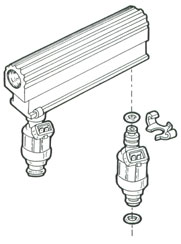 Your
Turbo Kit has two fuel rails. Each rail holds two fuel injectors.
Fuel enters from one end of the fuel rail and flows out the other
end. The system is designed to operate at pressures up to 80 P.S.I
and some times more depending on the application. Rapid flow of fuel
through the system is needed to reduce heat build up and to eliminate
vapor lock. High fuel pressure is also essential to allow the injector
nozzles to atomize the fuel and project the proper spray pattern into
the intake valves.
Your
Turbo Kit has two fuel rails. Each rail holds two fuel injectors.
Fuel enters from one end of the fuel rail and flows out the other
end. The system is designed to operate at pressures up to 80 P.S.I
and some times more depending on the application. Rapid flow of fuel
through the system is needed to reduce heat build up and to eliminate
vapor lock. High fuel pressure is also essential to allow the injector
nozzles to atomize the fuel and project the proper spray pattern into
the intake valves.
Start the assembly
of the fuel rails by threading the barbed fittings into each fuel
rail. The brass fittings can be replaced with A/N fittings and stainless
line. How ever you plan on doing it, be sure to use Teflon tape on
all threaded fuel fittings. Don't let strings of Teflon proceed the
end of the threaded fittings into the tapped holes. As good as Teflon
is, it can raise havoc with fuel pressure regulators and electronic
fuel injectors. Make certain to use steel hose clamps at every connection.
When using rubber line, make sure it is high pressure fuel line. When
installing the brass fittings, there are three 1/4" NPT x 3/8"
hose fittings and one 1/4" NPT x 5/16" hose fitting. The
5/16" fitting can be threaded in either of the two fuel rails.
But when it's time to secure the fuel rails, the rail with the 5/16"
fitting should be installed in the throttle body that will be closest
to the Fuel Pressure Regulator. Refer back to (page 2 - drawing #1)
for illustration on how to run your fuel system.
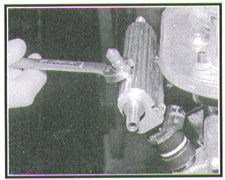 Locate
the Schrader Valve and a 1/8" pipe plug provided in the kit.
The Schrader Valve can be installed in either side of the engine,
it's best to install it where you will have the most access to it.
The Schrader Valve will be used to check the fuel pressure later on.
When you have the valve installed, the 1/8" pipe plug has been
provided to plug the hole in the other fuel rail. Remember to use
Teflon tape on all fittings. Don't over tighten, pipe threads are
tapered and seal with very little effort.
Locate
the Schrader Valve and a 1/8" pipe plug provided in the kit.
The Schrader Valve can be installed in either side of the engine,
it's best to install it where you will have the most access to it.
The Schrader Valve will be used to check the fuel pressure later on.
When you have the valve installed, the 1/8" pipe plug has been
provided to plug the hole in the other fuel rail. Remember to use
Teflon tape on all fittings. Don't over tighten, pipe threads are
tapered and seal with very little effort.
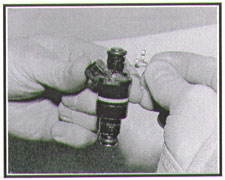 Four
clips are required to secure the injectors to the fuel rails. The
clips are pushed onto the top groove of each injector. Then push each
injector into a port on both fuel rails. To ease the installation
of the injectors into the fuel rails, it is a good idea apply a small
amount of oil to the "O" rings. With a little but of pressure
the injectors should slide right in. Excessive force should not be
necessary. No hammering! Once the injectors have been pushed in, check
to make sure the clips are secure over the edge of the fuel rail.
Installing the completed fuel rail assembly into the throttle body
or manifold, depending on application, is simply accomplished by lining
up the injectors with the ports, then pushing them down until they
feel like they are in all of the way. They should bottom out. If not,
check your alignment.
Four
clips are required to secure the injectors to the fuel rails. The
clips are pushed onto the top groove of each injector. Then push each
injector into a port on both fuel rails. To ease the installation
of the injectors into the fuel rails, it is a good idea apply a small
amount of oil to the "O" rings. With a little but of pressure
the injectors should slide right in. Excessive force should not be
necessary. No hammering! Once the injectors have been pushed in, check
to make sure the clips are secure over the edge of the fuel rail.
Installing the completed fuel rail assembly into the throttle body
or manifold, depending on application, is simply accomplished by lining
up the injectors with the ports, then pushing them down until they
feel like they are in all of the way. They should bottom out. If not,
check your alignment.
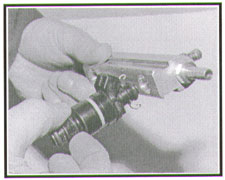 There
are two different styles of throttle bodies, and two styles of fuel
rail retaining brackets. Your engine will run without retaining brackets,
but a healthy backfire or turbo boost could possibly blow the injectors
out of their ports.
There
are two different styles of throttle bodies, and two styles of fuel
rail retaining brackets. Your engine will run without retaining brackets,
but a healthy backfire or turbo boost could possibly blow the injectors
out of their ports.
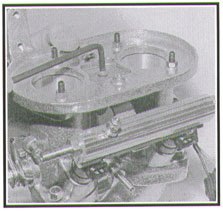 There
are two fuel rail retaining brackets, one for each throttle body.
The brackets provide a safety factor and must be installed. The brackets
are mounted to the throttle body and the bottom of the fuel rail with
6mm allen head bolts, washers and nyloc nuts. The retaining brackets
have two different size holes. The end with the straight cut hole
is fastened to the throttle body side. The other end with the oval
shaped hole is normally fastened to the fuel rail side for ease of
alignment. There two short (6 x 10mm) and two long (6 x 25mm) bolts.
The 6 x 25mm bolt, two washers and a nut. After the bolt has been
pushed through the throttle body from the top side, slide the bracket
on then the washer followed by a nut. Both fuel rails have been drilled
and tapped to accept 6mm bolts. They require no nuts. Line the retaining
bracket up with the fuel rail and thread in the 6 x 10mm bolt. In
the future if you need to remove the fuel rail/injector assembly do
it at the fuel rail side of the bracket by removing the short 6 x
10mm bolt.
There
are two fuel rail retaining brackets, one for each throttle body.
The brackets provide a safety factor and must be installed. The brackets
are mounted to the throttle body and the bottom of the fuel rail with
6mm allen head bolts, washers and nyloc nuts. The retaining brackets
have two different size holes. The end with the straight cut hole
is fastened to the throttle body side. The other end with the oval
shaped hole is normally fastened to the fuel rail side for ease of
alignment. There two short (6 x 10mm) and two long (6 x 25mm) bolts.
The 6 x 25mm bolt, two washers and a nut. After the bolt has been
pushed through the throttle body from the top side, slide the bracket
on then the washer followed by a nut. Both fuel rails have been drilled
and tapped to accept 6mm bolts. They require no nuts. Line the retaining
bracket up with the fuel rail and thread in the 6 x 10mm bolt. In
the future if you need to remove the fuel rail/injector assembly do
it at the fuel rail side of the bracket by removing the short 6 x
10mm bolt.
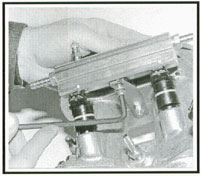 The
manifold style is a little more basic. There are still two retaining
brackets though, one for each side. Locate the two small rectangular
aluminum pieces with one hole drilled through it at one end. You will
also need four 8 x 12mm nuts. Thread a nut onto the long 8 x 60mm
stud. Thread it down far enough so that there is enough room to slide
the retaining bracket on followed by one more 8 x 12mm nut. The preferred
amount of clearance between the fuel rail and the retaining bracket
should be about 1/32". It's not necessary to run the nuts down
so far that when they are tight, the retaining bracket forces against
the fuel rail. Too much pressure can cause the "O" rings
to link when under pressure. Repeat this procedure on the other side.
The
manifold style is a little more basic. There are still two retaining
brackets though, one for each side. Locate the two small rectangular
aluminum pieces with one hole drilled through it at one end. You will
also need four 8 x 12mm nuts. Thread a nut onto the long 8 x 60mm
stud. Thread it down far enough so that there is enough room to slide
the retaining bracket on followed by one more 8 x 12mm nut. The preferred
amount of clearance between the fuel rail and the retaining bracket
should be about 1/32". It's not necessary to run the nuts down
so far that when they are tight, the retaining bracket forces against
the fuel rail. Too much pressure can cause the "O" rings
to link when under pressure. Repeat this procedure on the other side.
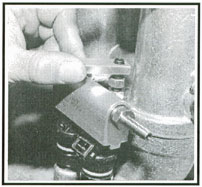 Each
throttle body is equipped with a threaded vacuum port. The port is
used to supply vacuum (manifold pressure) to the fuel pressure regulator.
The vacuum port feeds from an internal passage that sense manifold
pressure from both intake ports. The internal passage provides a dampening
action between the intake ports which levels out the manifold pressure
signal en route to the fuel pressure regulator. Locate the brass barbed
fittings (2), 1/8" NPT x 1/4" hose. Wrap the threaded ends
of the fittings with Teflon tape, thread one into each throttle body
vacuum port and snug'em down. Snug is enough, we're dealing with tapered
pipe threads, and over tightening could result in a cracked vacuum
port.
Each
throttle body is equipped with a threaded vacuum port. The port is
used to supply vacuum (manifold pressure) to the fuel pressure regulator.
The vacuum port feeds from an internal passage that sense manifold
pressure from both intake ports. The internal passage provides a dampening
action between the intake ports which levels out the manifold pressure
signal en route to the fuel pressure regulator. Locate the brass barbed
fittings (2), 1/8" NPT x 1/4" hose. Wrap the threaded ends
of the fittings with Teflon tape, thread one into each throttle body
vacuum port and snug'em down. Snug is enough, we're dealing with tapered
pipe threads, and over tightening could result in a cracked vacuum
port.
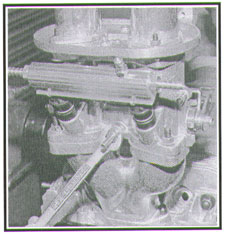

Bolt the completed
throttle body/manifold assemblies to the cylinder heads. Before positioning
the cylinder head to manifold gaskets on the cylinder heads, make
sure the sealing surface is clean and free from any old gasket material.
Make certain to use the gaskets supplied in your kit. Stock gaskets
will not tolerate the pressures of a turbo and will blow out. Line
up the intake manifold assemblies with the mounting studs on each
head and slide them onto the cylinder heads. Install two 8mm nuts
at the base of each manifold and slowly tighten them. The manifolds
and throttle bodies will pull inwards as the nuts are tightened. Torque
the nuts down to about 14 pounds.
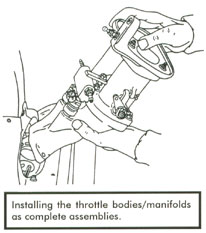
Now
back to setting up the linkage. Assembling the linkage is a carbon
copy of the procedures followed during the installation of dual carburetors.
Start by sliding the aluminum linkage arms and throttle cable bracket
onto the steel hex cross bar. The arms are locked in place with allen
set screws. The throttle cable bracket locates one hex degree down
from the linkage arms. Don't tighten anything down just yet, we'll
do that once everything is lined up properly.
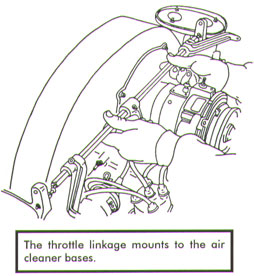 Internal
tension springs are places in each end of the cross bar to aid in
centering the cross bar assembly. Place a small amount of heavy grease
inside the support holes at each end of the cross bar. Insert the
tension springs and place the left end of the hex bar over its respective
cross bar swivel ball. Push the cross bar onto the swivel ball and
line up the right side end of the cross bar with its cross bar swivel
ball. If it is necessary to loosen one base, do so and line up the
cross bar with the swivel mount and then re-secure the base. Hopefully
your installation of the cross bar assembly has gone smoothly up to
this point. If not, as we mentioned earlier when installing the a/c
bases, there are different variables when building an engine. The
width of your engine may differ from stock. It may be necessary to
shorten or lengthen the length of the cross bar so that enough clearance
is provided on the cross bar swivel balls. If the clearance is too
far off, it may be necessary to purchase a new cross bar with the
correct length so that the installation is done correctly.
Internal
tension springs are places in each end of the cross bar to aid in
centering the cross bar assembly. Place a small amount of heavy grease
inside the support holes at each end of the cross bar. Insert the
tension springs and place the left end of the hex bar over its respective
cross bar swivel ball. Push the cross bar onto the swivel ball and
line up the right side end of the cross bar with its cross bar swivel
ball. If it is necessary to loosen one base, do so and line up the
cross bar with the swivel mount and then re-secure the base. Hopefully
your installation of the cross bar assembly has gone smoothly up to
this point. If not, as we mentioned earlier when installing the a/c
bases, there are different variables when building an engine. The
width of your engine may differ from stock. It may be necessary to
shorten or lengthen the length of the cross bar so that enough clearance
is provided on the cross bar swivel balls. If the clearance is too
far off, it may be necessary to purchase a new cross bar with the
correct length so that the installation is done correctly.
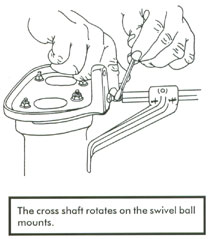
Now screw the
swivel balls out until the cross bar is fully supported by the swivel
ball mounts. Center the cross bar linkage assembly by rotating the
swivel balls. Adjust the length of the swivel ball mounting screws
until the cross bar is centered. Over tightening, resulting in not
enough side play, will cause the linkage bar to bind. Leave about
an 1/8" of side play and tighten up the swivel ball lock nuts.
Make certain that the cross bar is free to rotate on its axis. Any
resistance or binding of the cross bar can be a real problem later.
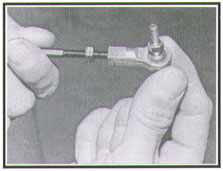 The
linkage rods and heim joints are next. There are four heim joints
in all. Two right hand and two left hand heim joints. Each side will
need one of each. The linkage rods are equipped with matching right
and left hand threads. Once installed you'll be able to fine tune
your throttle adjustments by rotating the throttle rods. After all
adjustments are made, lock them into position by tightening down the
lock nuts. The lock nuts are also supplied in right and left hand
threads. Leave the lock nuts loose for now. After the assembly of
the linkage rods is done, secure them to the cross bar linkage arms
and the throttle body linkage arms. You will need two open end wrenches
for this operation, an 8mm and 3/8". Thread the four shake proof
nuts down on all four heim joint connections. Not all of the way through,
leave them a little loose for now.
The
linkage rods and heim joints are next. There are four heim joints
in all. Two right hand and two left hand heim joints. Each side will
need one of each. The linkage rods are equipped with matching right
and left hand threads. Once installed you'll be able to fine tune
your throttle adjustments by rotating the throttle rods. After all
adjustments are made, lock them into position by tightening down the
lock nuts. The lock nuts are also supplied in right and left hand
threads. Leave the lock nuts loose for now. After the assembly of
the linkage rods is done, secure them to the cross bar linkage arms
and the throttle body linkage arms. You will need two open end wrenches
for this operation, an 8mm and 3/8". Thread the four shake proof
nuts down on all four heim joint connections. Not all of the way through,
leave them a little loose for now.
Position the
aluminum linkage arms on the cross bar so that the throttle linkage
rods are vertical when viewed from the rear of the engine. Lock the
aluminum linkage arms into position by tightening the allen set screws
to prevent the aluminum linkage arms from sliding on the cross bar.
Slide the aluminum throttle cable arm into position to line up with
the throttle cable and tighten down the set screw. Now check the installed
linkage rods, both left and right, making certain that the rods rotate
freely. Observe the way the rotation changes the length of the rod
assembly. Up to this point the linkage assembly should work freely
without any drag or binding. If there is any type of resistance, something
is not right. Go back and double check your installation. If everything
is in correct working order, tighten up the shake proof lock nuts
that secure the heim joints to the upper and lower linkage arms. Tighten
these to no more than 2 lbs. of torque.
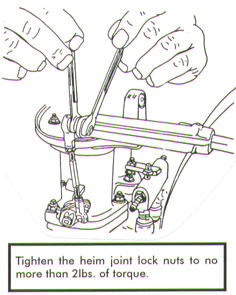 The
trick now is to get your linkage aligned to match your preset throttle
bodies. Adjust the throttle linkage rods by rotating in right or left
hand directions, until both throttle arms are resting on the idle
speed set screws. By rotating the linkage rods you'll be able to extend
or shorten the length of the rods. This will allow you to match the
preset throttle bodies.
Do not change the
position of the idle speed set screws to match your linkage. You already
set both throttle bodies to the same opening.
Adjust the
linkage to match the throttle bodies.
The
trick now is to get your linkage aligned to match your preset throttle
bodies. Adjust the throttle linkage rods by rotating in right or left
hand directions, until both throttle arms are resting on the idle
speed set screws. By rotating the linkage rods you'll be able to extend
or shorten the length of the rods. This will allow you to match the
preset throttle bodies.
Do not change the
position of the idle speed set screws to match your linkage. You already
set both throttle bodies to the same opening.
Adjust the
linkage to match the throttle bodies.
When you think
that you've got the linkage dialed in, push the aluminum throttle
arm downwards and watch the linkage arms as they move from closed
to open. If one throttle body "leads" the other, you've
got some more dialing in to do. The opening and closing throttle action
of fuel injection with dual throttle bodies is just like dual carburetors,
it has to be precise. So play with your linkage until it works like
a Swiss watch. Don't try to reinvent the linkage system. Simply adjust
it to match your
preset throttle bodies
and tighten up the four lock nuts on the throttle linkage rods.
Look over the
complete assembly carefully prior to connecting the throttle cable.
The cross bar linkage assembly should work accurately and freely.
Both throttle bodies should snap to closed position when the linkage
is released without protest.
Connect the
throttle cable. Have someone operate the throttle pedal from inside
the car while you watch the action taking place in the engine compartment.
Make certain that the pedal attains the end of its "stroke"
at the same time or slightly before the throttle reaches full open.
Excessive travel of the throttle pedal can bend the throttle linkage.
It may be necessary to install a throttle pedal stop to control or
limit pedal movement. If the drag of the throttle cable and pedal
seem to be slowing down the closing action of the linkage, it may
be necessary to install two helper throttle return springs. The helper
springs will provide a safety factor and should be seriously considered
for use on any type of vehicle. The slight amount of increase in throttle
pressure will never be noticed.
The rest of
the fuel system can now be completed. Up to this point all fuel line
(hard line), fuel pump/fuel filter, throttle body/manifold assembly
and throttle linkage have been installed. The main line (previously
installed) needs to be hooked up to the front of the passenger side
fuel rail (flywheel side). Keep in mind, your fuel system may differ
from that of what is being described, you may have decided to route
your system differently. Use the supplied 3/8" fuel line to make
the required connections. Always use clamps to secure connections.
Now run a line from the back of the passenger side fuel rail (pulley
side) across the engine to the back of the drivers side fuel rail.
All connections up to this point should have been done with 3/8"
line. The remaining connection needs to be 5/16" line, and it
runs from the front of the drivers side fuel rail (flywheel side)
to the inlet side of the Fuel Pressure Regulator. Connect the outlet
side of the regulator to the return line going to the fuel tank. This
will complete the fuel system. Refer back to drawing #1 for illustration.
Previously there
were two 1/8" NPT x 1/4" hose barbed fittings threaded into
the throttle bodies. Those fittings will now be used to supply vacuum/pressure
to the MAP sensor and Fuel Pressure Regulator. Mount the Map sensor
before running the vacuum line. We suggest mounting the MAP sensor
someplace on the fan shroud, front or back. This will keep it close
enough for the wire loom to reach and away from heat at the same time.
Refer to (drawing #2) for illustration on hooking up the vacuum line
system. In the kit, there are two 1/4" brass "T's"
and a section of 1/4" rubber vacuum line. Use this to run the
Vacuum/Pressure System for the regulator and MAP sensor.
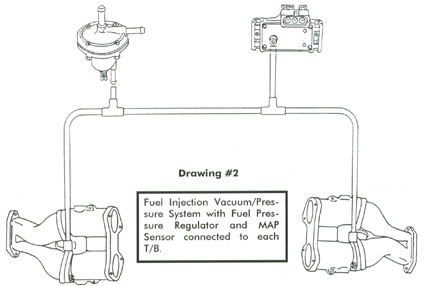
The wiring harnesses
supplied by CB Performance are complete and ready to snap on. The
GM Weather Pack connectors are designed for easy installation. Each
connector is marked as to usage and keyed to fit only one application.
High performance turbo charged engines use only thee engine sensors:
1. TPS - The
throttle position switch is mounted on the right side throttle body.
The exact throttle position in degrees is reported to the computer
while the engine is switched on. The computer uses the combined TPS
signal, engine RPM and MAP signal to control the pulse rate of the
injectors. The injectors are turned off during deceleration.
2. CHT - The
cylinder head temperature sensor, monitors the temperature of the
left side cylinder head. The computer uses information to adjust the
air/fuel mixture to compensate for cold start, warm up and fuel delivery
during high engine temperature. If your cylinder head is not equipped
with an OEM injection boss, it will be necessary to drill and tap
(1/8" NPT.) the left side cylinder head as shown to provide a
mounting location for the CHT.
3. MAP - A manifold
air pressure sensor measures the pressure within the intake system.
Manifold air pressure will vary from 30 inches of vacuum during deceleration
to 20 pounds of pressure during periods of turbo boost. Positive MAP
signals, signal the computer to increase the pulse rate of the fuel
injectors to provide enrichment during boost.
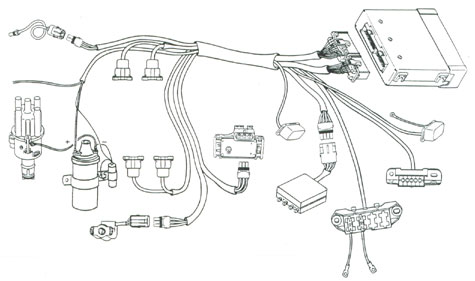
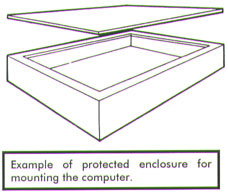 Your
computer (ECM) is mounted inside a sturdy aluminum chassis. This enclosure
is rugged and designed to withstand severe shock and rapid temperature
changes. However the outer shell is
not
moisture proof. If you plan on operating your vehicle in wet or moist
conditions, it's advisable to mount your computer in the driest possible
location and provide further moisture protection in the form of a
heavy duty plastic zip cover or outer enclosure. Various types of
plastic snap together boxes and trays are available for this purpose.
Aluminum boxes in various sizes are also available that provide a
secure moisture resistant installation.
Your
computer (ECM) is mounted inside a sturdy aluminum chassis. This enclosure
is rugged and designed to withstand severe shock and rapid temperature
changes. However the outer shell is
not
moisture proof. If you plan on operating your vehicle in wet or moist
conditions, it's advisable to mount your computer in the driest possible
location and provide further moisture protection in the form of a
heavy duty plastic zip cover or outer enclosure. Various types of
plastic snap together boxes and trays are available for this purpose.
Aluminum boxes in various sizes are also available that provide a
secure moisture resistant installation.
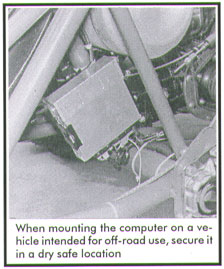 The
computer should be mounted away from engine heat and in a protected
location. Locate the wire connector and of the computer downward if
the computer is to be mounted vertically. This will help keep any
foreign debris away from the terminals. Check the length of the harness
before you mount your computer. This kit doesn't include wire stretchers,
so plan your harness layout before you mount the computer, fuse block,
or other electronic components. When your satisfied with the harness
layout, mount the computer in as dry and secure a location as possible.
And no, the computer won't work under water! If mounted properly,
it's moisture resistant, but not water proof.
The
computer should be mounted away from engine heat and in a protected
location. Locate the wire connector and of the computer downward if
the computer is to be mounted vertically. This will help keep any
foreign debris away from the terminals. Check the length of the harness
before you mount your computer. This kit doesn't include wire stretchers,
so plan your harness layout before you mount the computer, fuse block,
or other electronic components. When your satisfied with the harness
layout, mount the computer in as dry and secure a location as possible.
And no, the computer won't work under water! If mounted properly,
it's moisture resistant, but not water proof.
Do no
use silicon based sealers in an attempt to prevent moisture from entering
the computer. Silicon sealers contain acetic acid. Acetic acid emits
corrosive gasses during its curing stage. These gasses can cause severe
corrosion of the computer and wiring terminals. It's effect on solder
joints is well documented.
Your computer
has two male connector plugs. A large one and a small one. The female
connectors on the harness are keyed and will only plug in one way.
The connectors are held in place by tension snaps. Depressing the
snap lever releases the connector to allow it to be removed.
The ALDL (scan
port) connector can be located in any convenient location. The ALDL
provides system access to allow the use of a diagnostic scanner. Your
CFI system is GM compatible and can be accessed under GM 1990 L 05
5 27R. The scan will indicate engine RPM, temperature, TPS setting,
injector pulse rate and condition of the voltage system.
Position and
mount the fuse block in a dry, convenient location that provides easy
access for servicing the fuses. Each CFI system includes two relays.
They are connected to special five pin terminal plugs that only plug
in one way. Mount the relays in a protected area. One relay operates
the entire system. The other operates the fuel pump. The fuel pump
relay is equipped with a fuel pump lead wire. The lead wire is marked
(+) positive, and fitted with a round lug ring. It connects to the
(+) positive terminal on the fuel pump. The (-) negative terminal
on the fuel pump must be routed to ground. Use the supplied piece
of secure it to a good clean ground. Use the supplied piece of wire
and lug rings. Make certain to secure it to a good clean ground.
The fuel pump
is activated by the computer. A special timing circuit in the computer
will turn the fuel pump off when the ignition is left on with the
engine not running. The computer will also turn the fuel pump off
should the engine stall and the ignition is left on. The fuel pump
will restart when the ignition is switched off, and then back on.
|
|
|
The
computer can be located under or behind the rear seat in a VW
Sedan.
Do not mount the computer in
the engine compartment.
Excessive heat will damage
the internal components.
|
Connect the
four injector connectors coming from the harness. Each connector is
numbered with a corresponding cylinder number. The plastic connectors
simply push onto the injectors. They are held in position by wire
snaps. Make certain to position the wires so that they don't interfere
with the throttle linkage. Tie the wires with nyties to prevent them
from being pulled into the cooling fan (if necessary). Connect the
red wire marked (+) positive, to the hot side (12 volt) of the ignition
coil. Connect the fused ignition lead to the "switched"
hot side of the ignition switch.
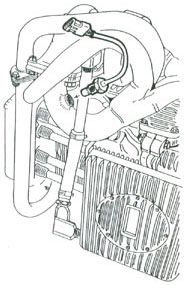
|
|
Although
it's not necessary for the use of an oxygen sensor with this
system, it is necessary to use one if you plan to use an Air/Fuel
Monitor.
|
CB's new Competition
Turbo System can be used with most any type of ignition with the exception
of magnetos. Breaker point, solid state, crank fired and other ignition
systems can be used. A 40,000 volt MAGNASPARK HEI ignition system
is ideal for use with a turbo system because it supplies a much hotter
spark than other types of ignition.
You don't have
to get fancy and recurve your distributor, just set it for a total
advance not to exceed 24 degrees BTDC. This will provide enough retard
to get the engine and enough advance for smooth driving. A maximum
spark setting of 24 degrees BTDC will help suppress pre-ignition during
boost. The use of "cold" spark plugs is also recommended.
Ignition systems
that provide reduced spark settings during boost can also be used.
A fully computer controlled ignition system is available from CB.
This system requires the main harness to have three additional wires
installed during production of the harness. This system will automatically
retard your ignition timing from 32 degrees with no boost to 24 degrees
with 10 lbs. of boost.
|
|
|
Fuel
Injection can be used with standard BOSCH ignition systems or
computer controlled 40,000 volt HEI systems. Computer controlled
HEI systems automatically controls the spark curve.
|
Ignition
systems other than our computer controlled ignition requires a Tac
Filter. A Tac Filter allows your analog ignition to talk to the digital
computer. The Tac Filter creates a signal that the computer can recognize.
The Tac Filter
is contained in an aluminum can with a mounting tab. The Tac Filter
should be firmly mounted and grounded on or near the coil bracket.
Three wires lead from the Tac Filter. One wire affixed with a round
eyelet suitable for securing to the distributor clamp stud (ground).
The other wires leading from the Tac Filter, one affixed with a single
Weather-Pack terminal and the other affixed with a single spade terminal.
The Weather-Pak terminal plugs into the loom and the spade terminal
goes to the ground terminal on the coil.
Important Updated Information
Make sure to fit your
header to the Engine
BEFORE any aftermarket coating. Customer assumes
the any responsibility for the header, after coating
When
using an aftermarket ignition system, such as MSD or a complete
COMPUFIRE DIS-IX system, refer to the following pages for important
installation procedures and wiring diagrams. In instances where
engine "run on" is occurring (when engine stays running
when you turn key off) there is a wiring diagram to guide you through
curing this simple problem.
Tuning
your Turbo System
|
|
|
Front
view of the control module and location of adjusting knobs.
The module needs to be mounted in a location where the driver
can easily reach it and also won't get disturbed.
|
The
yellow light marked LOW, will light when the ignition is turned on.
It will remain lit until the engine reaches boost stage. At that time,
the LOW light will turn off and the Boost Light will ignite. Boost
pressures are reached only when the engine is in gear and under load.
With free reving (without load) the engine will not develop enough
exhaust flow to produce boost pressure.
The fuel pressure
is set by removing the cap nut from the top of the fuel pressure regulator
and loosening the lock nut on the threaded shaft. Fuel pressure is
increased by rotating the adjusting shaft clockwise. Pressure can
be checked at the Schrader valve located in the fuel rail. If you
don't have a special fuel injection kit, a tire pressure gauge will
get the job accomplished. When you have the pressure set, lock the
jam nut and replace the cap nut. Remove the jumper wire used to hot
wire the fuel pump and reconnect the fuel pump to the fuel pump relay.
Start your engine,
your fuel pressure will drop depending on the amount of vacuum produced
by your engine. Camshafts with less duration will produce more vacuum
which in turn will drop your fuel pressure accordingly. Vice versa
for engines with longer duration camshafts. Stabilize your engine
RPM high enough so that it can hold a steady idle. Your next procedure
is to use a Uni-Syn gauge and synchronize your throttle bodies. It
is very important to get your bodies in sync. Stable fuel pressure
is greatly influenced by a set of unbalanced throttle bodies. Once
you have achieved a balanced situation, stabilize your engine idle
between 800-900 RPM. Go back and recheck your fuel pressure, if it
has changed, readjust it to 50 P.S.I. at an idle. Balancing the throttle
bodies and adjusting the fuel pressure are two of the most important
steps to installing CFI. Please don't try to guess with these adjustments.
Now install
the air boxes and compressor ducting. Be sure to use the provided
clamps at all connections. Double check your installation for any
loose ends or leaks, hopefully everything checks out all right. Pick
everything up and make sure you don't have any tools lying around
on the car. It's time for a test drive. Refer back to page 14 for
in depth tuning adjustment instructions using the dash module. GOOD
LUCK!
|
DIGITAL
FUEL INJECTION - WHAT MAKES IT WORK?
|
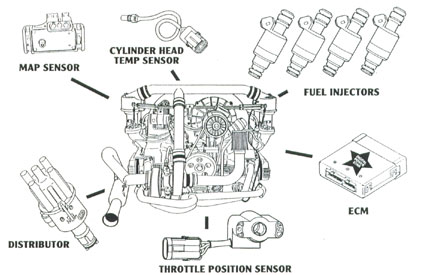
|
Blow
Through is Modern State of the Art!
|
|
|
Baja
- Rear engine dune buggy Competition Turbo Fuel Injection Kit
|
Function by
design truly pays off when you team up electronic fuel injection with
a compatible turbo-charger. The air flow capacity of four 48mm butterflies
opens up the door to some serious horsepower. A Schwitzer S1A turbo
with a 0.5 A/R ratio is able to flow enough pressure to push up to
20 P.S.I. of boost through engines up to 1900cc's. Larger engines
are able to generate the flow to spin a TO4 running an A/R ratio of
0.7. Keep in mind that
RACING FUEL will have to be used
any time that boost excedes about 15 P.S.I.
to prevent
pre-ignition and damaged parts.
Blow through
turbo systems are far more efficient than pull through turbos for
several reasons.
The benefits
start when the air enters the turbo in a pull through system. A turbo
is a pure CFM device and is very sensitive to the pressure of air
entering the compressor. Any restriction to entry flow, or drop in
air pressure will result in a marked reduction in flow, in pounds
per minute to the engine. Automotive engineers are very aware that
turbos by design, are much more efficient when used in blow through
systems. Who uses fuel injected blow through systems? Every major
automotive manufacturer who produces turbo engines.
Most of the
OEM turbo systems produced are of the plenum type where a common intake
chamber leads to all of the intake valves. A common plenum places
restriction on the duration of the camshaft. It's just one of those
facts of life. Long duration cams just don't like plenum intake systems.
The combination of a long duration cam and plenum intake results in
low speed flow reversion, wetted walls and loss of low speed engine
vacuum. Which means that these engined are tied to a short duration
camshaft. Camshafts with short duration place a limiting factor on
performance.
When a blow
through turbo system is matched to a set of smooth bore 48mm throttle
bodies you've got true port on port turbo power. This type of turbo
system can easily run camshafts with durations over 300 degrees and
still idle like an electronic watch. Bottom end torque has to be experienced
to be believed with port on port blow through injection. Port on port
provides even more flow than plenum turbo systems because four 48mm
throttle bores function with less resistance to flow than a single
throttle body.
What does all
of this high tech, high buck computerized discipline do for your VW
engine? It makes horsepower and runs trouble free. CB's Turbo EFI
engines continually achieve 300 HP on pump gas. These engines are
totally driveable and really add the relish to a dune buggy, VW Sedan
or Porsche kit car.
|
|
|
Turbo
Competition Injection - dial it in with more power than ever
before! It's simple, direct and at your finger tips.
|
Important
Notice about your car's fuel system
Fuel contamination
can be the cause of a poorly running engine. Even though your gas
tank is relatively new, it can still contain enough dirt, metal fillings
and other debris to plug up a kitchen sink. A close inspection of
most any dune buggy gas tank will quickly illustrate the end result
of contaminated storage tanks. Most five gallon fuel cans often have
junk waiting in the bottom to end up in your fuel tank. Make sure
this doesn't get you stranded.
Dirt, sand and
other sludge builds up in the filter as the fuel is circulated through
the system. The filter will eventually clog to the point that the
fuel will only trickle through the filter. When this happens the engine
will idle, and depending on the amount of fuel flow, might even run
at mid-speed. Full throttle operation with a partially plugged filter
will result in serious fuel starvation. Your engine will tell you
about this by popping and snapping out of the exhaust pipe as it goes
lean due to a lack of fuel.
This condition
is often misread as burnt points, fouled spark plugs and even tight
valves. Check your cars fuel filter on a regular basis. Check the
fuel filter as often as you check your oil if you operate your engine
in dirty conditions. Also make sure that the fuel filter and fuel
pump are installed in the correct order. First the fuel filter and
then the fuel pump. The filter can be quickly replaced, and if that
doesn't solve the problem, work your way through the following Trouble
Shooting Guide.
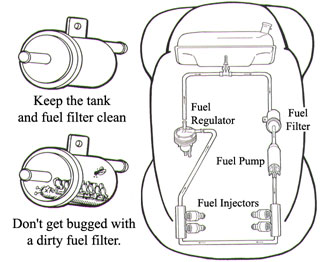
Competition
Turbo Injection Wiring Diagrams